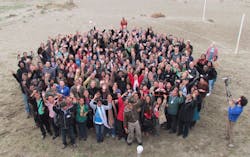One Year Later: Rana Plaza Responses Highlight Differences in European and U.S. Approaches to CSR
A year after the Rana Plaza collapse – the worst workplace disaster in the history of the garment industry – the occupational safety and health community is examining what has changed and what has remained business as usual.
Undoubtedly, one of the most significant changes spurred by the Rana Plaza disaster is the Accord on Fire and Building Safety in Bangladesh. Its most prominent features include: independent inspections by trained fire-safety experts, and public reporting of the inspection results; mandatory repairs and renovations financed by major retailers; a central role for workers and unions in both oversight and implementation; supplier contracts with sufficient financing and adequate pricing; and a binding pact to make these commitments enforceable.
While the accord isn’t a magic bullet to solve all of the labor-rights violations in the garment industry, it represents a new way of solving them – namely a joint approach by employers, labor organizations and trade unions.
In response, Gap Inc. and Wal-Mart Stores Inc. have developed their own Alliance for Bangladesh Worker Safety, along with 20 other North American retailers. Despite the impressive financial numbers that it bundles, critics point out that the alliance is voluntary, fails to hold members accountable and does nothing to prevent buyers from setting lower prices even if such prices make it financially impossible for factories to improve working conditions.
Furthermore, the audit results are not publicly transparent, and the alliance does not involve worker’s organizations and does not grant stop-work authority to employees if they observe unsafe conditions.
Consequently, while mimicking the rhetoric of the accord, the alliance merely recycles and bundles most of the existing CSR initiatives of the different brands. Those same CSR policies failed to prevent the Rana Plaza collapse or any of the other recent garment-industry tragedies, which has led to a great deal of skepticism about the impact of the alliance.
The accord and the alliance highlight the differences in the legal and business environments – and the differences in the approaches to corporate social responsibility – in Europe and the United States.
As Gap and Walmart where quick point out, the U.S. legal environment was the main reason they decided not to sign the accord. The companies asserted that signing the accord would expose them to unlimited liability (an argument that was quickly debunked by several legal experts).
Another angle is that Europe has a more mature labor-relations environment – and a stronger labor-rights movement – than the United States.
Even so, in the wake of the Rana Plaza tragedy, a broad coalition of stakeholders has worked together to convince North American companies to join the accord. These stakeholders include the International Labor Organization, the Organization for Economic Cooperation and Development, faith-based groups, legal experts, institutional investors and various members of Congress.
The vast majority of retailers that have signed the accord are from Europe, although 15 North American brands – including Abercrombie & Fitch, Fruit of the Loom and PVH (maker of Tommy Hilfiger and Calvin Klein) – are on the list.
Still, the framing of the accord as a European response versus a North American response merely is an attempt to shift the debate away from the alliance’s lack of substance. In the end, whereas the accord provides a new way of thinking about how to ensure labor rights in the global supply chain, the merit of the alliance seems to be simply that it’s not the accord – which is a hard sell.
The Clean Clothes Campaign is dedicated to improving working conditions and supporting the empowerment of workers in the global garment and sportswear industries. The campaign is an alliance of organizations in 16 European countries. Members include trade unions and NGOs covering a broad spectrum of perspectives and interests, such as women’s rights, consumer advocacy and poverty reduction.
Editor's note: This article originally was submitted for a special edition of EHS Today dedicated to Bangladesh and the global supply chain.
